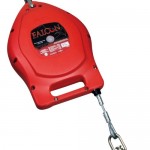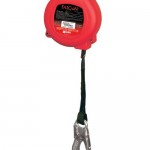Self-Retracting Lifelines: Exploring The Different Types and Their Purpose
 You might think that all Self-Retracting Lifelines (SRLs) connectors are pretty much the same. As long as they do the job of protecting your workers in the event of a fall, you might believe that one SRL performs just as well as another.
You might think that all Self-Retracting Lifelines (SRLs) connectors are pretty much the same. As long as they do the job of protecting your workers in the event of a fall, you might believe that one SRL performs just as well as another.
In fact, there are several different types of SRLs. It’s a good idea to understand the differences between the models. Depending on your environment, certain types of may last longer than others, and do a better job of protecting your personnel from fall hazards and other dangers.
One of the major differences in SRLs is the type of material that the lanyard cable is made of. (The lanyard is the actual “lifeline” component of the Self-Retracting Lifeline.) There are three types of lanyards within the SRLs themselves:
- Stainless Steel Lanyards
- Galvanized Steel Lanyards
- Nylon/Polyester Synthetic Webbing Lanyards
Let’s look at how each of these materials works in relationship to the work environment, and the fall protection system you need.
The Importance of an SRL Inspection
An important factor to remember is that all fall protection equipment deteriorates over time, regardless of who manufactures it. Everyday use of equipment and exposure to elements in the environment causes the material to wear out, and decreases its effectiveness in protecting users.
This is especially true of SRLs and other connectors. In the event of a fall, the SRL is the element that absorbs the shock of the fall and the weight of the worker. But over time, the effectiveness of the SRL lanyard deteriorates, and it is less able to absorb fall shock and worker weight. You don’t want one of your workers to be killed or seriously injured because they are using old equipment that suffers a failure at a crucial moment.
That’s why inspections are important. The user should do an inspection of their fall protection equipment every time before they use it. And a Competent Person should do a yearly (or more frequently depending on working or environmental conditions) inspection of all your equipment to make sure it is still in compliance with OSHA regulations and the safety standards of your workplace. If the worker or Competent Person inspector finds any damaged equipment (i.e. frayed or worn-out lanyards), your company should replace it immediately. Additionally, any fall protection equipment that has absorbed the impact of a fall should be immediately removed from service. In all cases, equipment that has been taken out of service should be marked in such a way that it cannot be accidentally used before it is discarded.
When To Use Steel Cable SRLs
 If you’re working in a corrosive environment, you should be aware of how the elements will affect the durability and longevity of your SRLs. In a steel mill, for example, the constant high heat and any edges or machinery that the SRL lanyards continuously rub against will take its toll on the equipment’s effectiveness. These and your other fall safety equipment will need to be replaced more often.
If you’re working in a corrosive environment, you should be aware of how the elements will affect the durability and longevity of your SRLs. In a steel mill, for example, the constant high heat and any edges or machinery that the SRL lanyards continuously rub against will take its toll on the equipment’s effectiveness. These and your other fall safety equipment will need to be replaced more often.
Stainless steel cables are the most durable type, and will last the longest. You can use them in extreme corrosive environments, such as in marine work (i.e. in seaports, on ships, on offshore platforms, etc.) where the salt water atmosphere takes a heavy toll on equipment. Stainless steel should be used if you plan to attach the device to an outdoor elevated work space (i.e. on a roof) and leave it there year-round, in all types of weather.
Galvanized steel cables are slightly less durable, but still suitable for most corrosive environments. You can use them in areas of constant heat, such as steel mills and boiler rooms. You can also use them in areas of constant cold, or in outdoor areas such as rail yards and truck loading facilities that are exposed to all kinds of weather.
Stainless and galvanized steel SRLs have a longer life in corrosive environments than those with synthetic webbing. Steel cable lanyards can withstand abuse better than synthetic webbing lanyards, and will also last longer after repeated use. If a synthetic webbed lanyard is exposed to a sharp edge, such as a roof sheet, it may cause failure in the form of a tearing. A steel cable lanyard will not be damaged by a sharp edge.
When To Use Nylon/Polyester Web SRLs
 Although steel cable SRLs are more durable, nylon/polyester web works just as well in less corrosive environments. For example, if you’re working in a climate-controlled distribution center where there are no sharp edges for the lanyard to rub against, a synthetic web SRL works fine. What’s more, your fall protection equipment will last longer in a non-corrosive environment, and won’t have to be replaced as often.
Although steel cable SRLs are more durable, nylon/polyester web works just as well in less corrosive environments. For example, if you’re working in a climate-controlled distribution center where there are no sharp edges for the lanyard to rub against, a synthetic web SRL works fine. What’s more, your fall protection equipment will last longer in a non-corrosive environment, and won’t have to be replaced as often.
There are some situations where a synthetic web SRL is preferable to a steel one. For example, in an airplane hangar or other aviation maintenance facility, workers must occasionally climb on top of aircraft to service or paint them. A steel cable lanyard may rub against the wing or a section of the fuselage and damage its paint job or, even worse, damage a crucial flight component. An SRL with a synthetic webbing lanyard is preferred because the material will not cause damage when it brushes against the aircraft.
Also, synthetic web should be used if you are in a manufacturing environment in proximity to an electric current. If a worker is using a steel cable SRL and the steel lanyard accidentally touches an electrical conductor, it will produce an electric shock, which could result in electrical injury or death.
In addition, synthetic web is lighter in weight than steel cable. This makes them easier on the user if they have to carry the apparatus apparatus over a longer distance, such as with a horizontal lifeline system.

